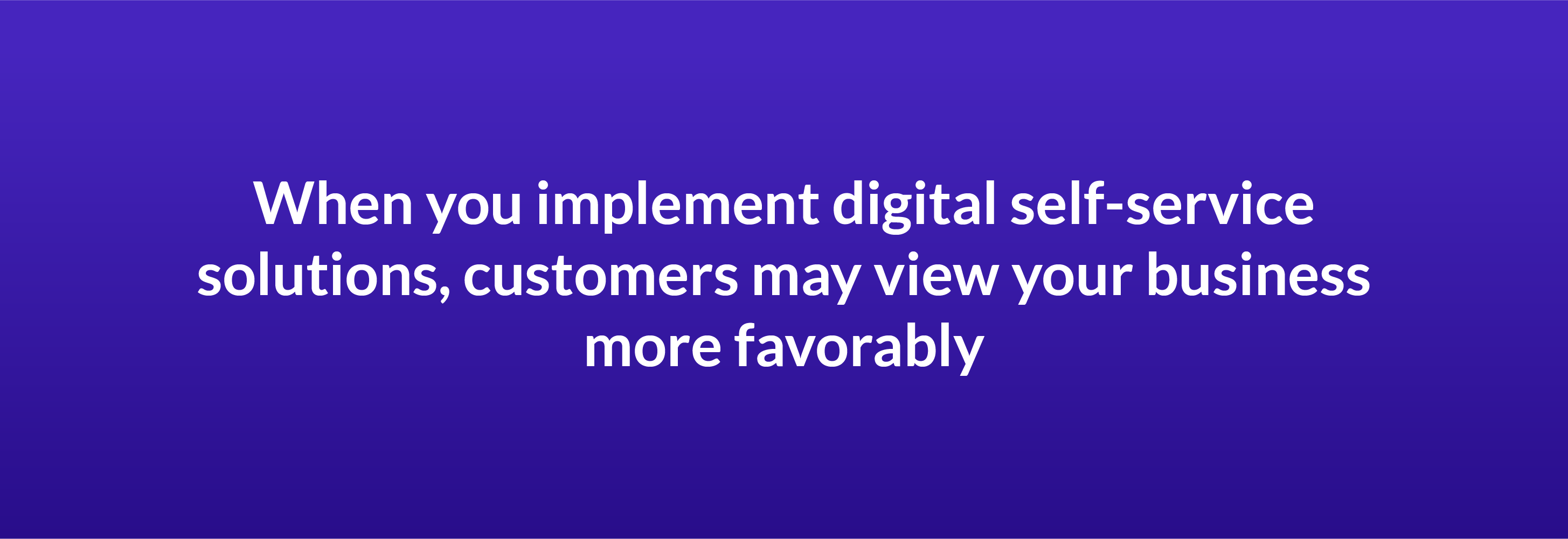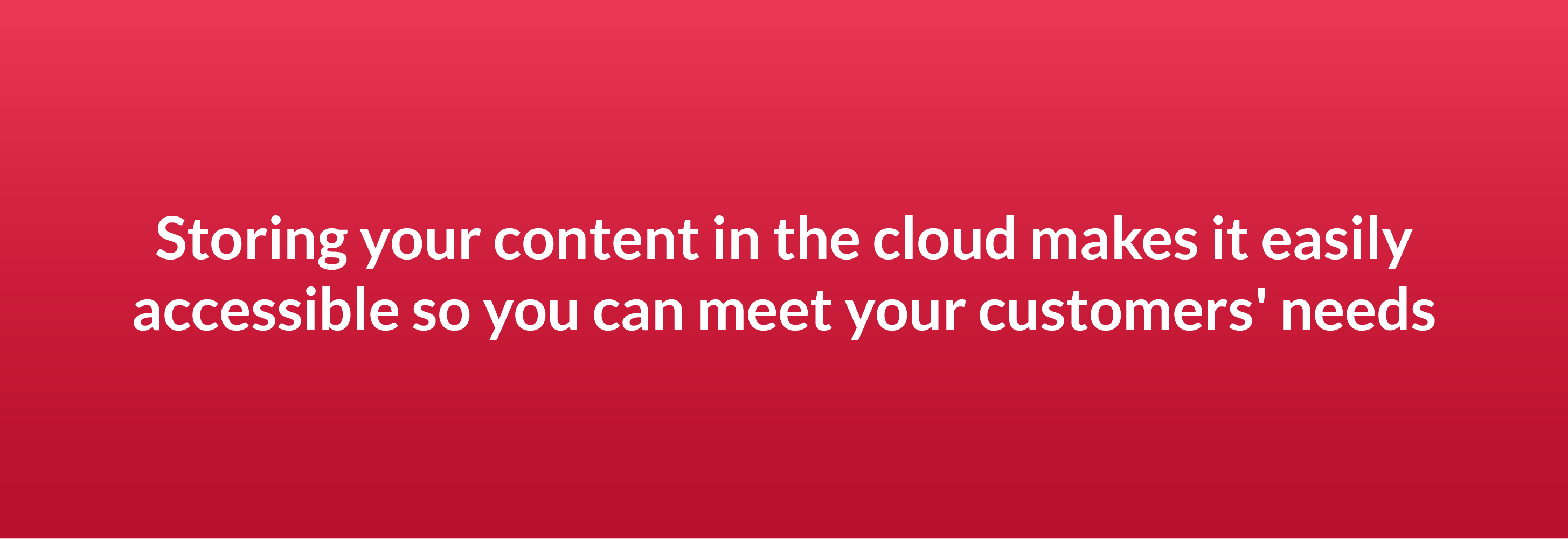Improving the customer experience with digital transformation
In the age of digital transformation, and with the increasing reliance on digital platforms, companies are under increased pressure to deliver stellar customer experiences. It's not simply a change in technology. Digital transformation is about changes in the way employees work, how customer interactions are managed, and how information is collected and used. Digital transformation, when done right, brings many benefits to organizations, including increased customer satisfaction and the chance for higher revenue.
Customer-driven changes
Customer service is at the center of every brick-and-mortar business, and a focus on customer satisfaction should drive digital business interactions as well. Customers expect your business to meet their needs digitally and to provide them with a great experience from anywhere and everywhere.

Digital transformations across industries are led by customers and their needs. The modern buyer expects accessibility, convenience, personalization, and efficiency. As the world increasingly relies on technology, consumers expect your organization's digital presence to be top-notch.
A customer's first interaction with your business will most likely be through a digital medium. Whether a customer reaches out to you or you reach them first through social media or other digital advertising, they expect you to make the effort to build a relationship.
It's not enough for your organization to be reactive. You must also be proactive in making connections with customers. The way to do this is through targeted, personalized, data-driven marketing. Customers know your organization can track and record their buying habits and preferences, so they expect to see marketing and advertising that's relevant to them — especially when they are loyal repeat customers.
Making the effort to satisfy your existing customers provides financial benefits. Customers who regularly patronize your business are 50% more likely to try new products or services you launch. Existing customers are also willing to spend up to 31% more on your products or services compared to new customers. Remember, it costs five times more to attract new customers as it does to retain existing ones.
Ultimately, if your business is not taking the necessary steps for a digital customer experience transformation, consumers will choose to interact with and support other brands that do.
What exactly is digital transformation?
Digital transformation means digitizing different aspects of your business to streamline operations, reduce costs, and ultimately better serve customers. Digitizing your business or organization often requires changes to company-wide operations. Depending on your industry, digital transformation may look like automating time-consuming processes or incorporating warehouse management software.
Through digital transformation, companies report seeing more engaged and satisfied customers, which leads to brand loyalty and increased sales. High-maturity companies, or companies that have successfully implemented digital transformation to deliver positive business impacts, report a 45% increase in net revenue growth, according to a 2020 Deloitte study.
The same study reports a 29% increase in new product or service sales as well as a 41% increase in the success of sales and marketing functions for high-maturity companies. The bottom line? Digital transformation is increasingly critical to the success of all businesses.
Creating a seamless experience
Customers don't want to jump through hoops while trying to buy a product or service. If the experience is difficult or unenjoyable, customers may move on to a competitor with a more streamlined buying process. Remember, you may find your business easy to understand, but that doesn't mean your customers will. Take a customer-first approach and view every aspect of your business through the eyes of your customers.
Every department in a business can center around customer service. Relying on only one department, such as customer support, to handle all of your customer service may make your company seem disingenuous. Customers want to feel their needs are respected and met at all levels of the organization.

It's not enough to purchase and adopt technology. To ensure the customer experience is seamless means keeping that technology updated, conducting regular employee trainings, and constantly evaluating your apps and tech stack.
When your team members are properly trained to use cloud software that puts content in a central location, they gain access to data to make each customer's experience enjoyable and as pain-free as possible. A quick look at the customer's transaction history will allow your customer service team to better approach customers and create an efficient and successful interaction.
Understand customer pain points
Identifying and addressing customer pain points allows you to better serve consumers. As customers' needs and expectations change over time, revisit your approach to evaluate if it's still addressing customer pain points adequately.
Pain points might include a variety of different inconveniences to the customer, but generally, they fall into four different categories:
- Financial
- Productivity
- Process
- Support
Common financial pain points for customers include high membership or subscription fees or high price points for products. Consider if your products and services are priced accurately and how you can get customers to see the product's value.
Productivity pain points often represent a difficult purchasing process. Think about how you can simplify the customer's experience while trying to make a transaction.
Process pain points might refer to customers struggling to get in touch with the right departments. Digitization can make it easier for customers to navigate to the correct team to help with any issues or questions.
When customers do get in touch with the correct department, they expect to speak to a knowledgeable representative. Slow response times and employees who lack product or company knowledge will create support pain points. Customers also expect contact methods that are convenient from any place or device. So, in the process of digital transformation, your organization may need to develop chat services and other digital methods to connect your buyers with customer support on various devices.
Making holistic, organization-wide changes
When digitizing your business or organization, expect to have to make organization-wide changes. Because different teams and departments need to work together to meet customer expectations, you can't limit digital transformation to just one area of your business. When customers share problems, concerns, suggestions, or requests with the support team or another front-end team, this information needs to make it to back-end team members. Digitization makes it easier for different parts of your organization to work together.
Implementing a company-wide customer relationship management (CRM) platform gives all team members access to vital customer information and feedback. This accessibility allows all your departments to be on the same page.
To put it simply, you need to implement your digital transformation across your organization to deliver a customer experience that efficiently and adequately addresses buyer pain points. That's what makes the cloud such a vital tool.
Using the cloud allows employees to easily collaborate. In industries where processes need several rounds of approval, the cloud makes it easy to quickly and securely pass along documents to move to the next step of the process. When teams can easily work together from anywhere, customers see faster results.
Contactless self-services
Increasingly, customers prefer contactless services, like self-checkout machines and checking in for flights through a phone app. By providing self-service options, your company could competitively position itself — 77% of customers have a more positive view of businesses that offer self-service support options.

If customers prefer handling issues themselves and enjoy controlling their own shopping experience, how do you ensure they still leave with a great impression of your organization? The answer is to digitize customer experiences through natural language processing, artificial intelligence (AI), and other self-service technologies.
Digitization of the customer experience adds convenience, as customers no longer need to wait in a queue to speak to a representative. Most of their questions can be answered online through resource pages or AI chats.
Online ordering is another digital way to add convenience. Customers can quickly make purchases without having to speak to any representatives, wait in lines for checkouts, or shop during certain store hours.
Consumers seek out businesses that offer self-service opportunities. Is your company ready to meet this customer expectation?
Prioritizing security
Security is always a priority for any organization, but the emphasis on security increases as more and more organizations move toward the digitization of customer experiences. For industries that store customer information, cloud security is important.
Customers expect their financial and personal information to be protected from cyberattacks and other security threats. Ensuring your cloud provider or software has features like encryption and password protection is crucial. Additionally, employees need to be properly trained on how to safely use the software as well as how to identify potential security issues.
Eliminating outdated software
As technology continues to improve and evolve, cyberthreats evolve, as well. So, to reduce risk, you need software that understands and is capable of handling potential threats. Another way to ensure security is by using up-to-date software that can prevent current threats.
Consumers also prefer modern digital experiences, particularly when they use your app or visit your website. Outdated software can leave a bad impression on customers and even make them question how secure their information is.
CRMs and automation
Automation streamlines your current processes to save you time and money. It also allows your staff to work more efficiently. With information at the tips of their fingers, team members can focus on customer satisfaction and other creative efforts that require a human touch.
When repeat customers receive personal greetings or customized recommendations, they tend to feel more valued. Specifically, a CRM allows sales and marketing professionals within your organization to avoid starting from scratch each time a consumer engages with the organization. With a CRM, team members will be able to more accurately address each customer's individual needs and preferences because the data is saved in the CRM.
The critical role of cloud technology
Cloud technology allows organizations to be dynamic, flexible, and fast. The cloud connects all of your customer touchpoints. From CRMs to website and app data, you can create a full picture of your customer base and, as a result, better understand how to meet its needs.

The cloud allows your organization to store all of its content and information in one safe place. Cloud access makes collaboration easier, too, because team members can work from anywhere, access the same information, and unify content from a variety of different apps. With higher productivity rates and streamlined workflow, employees work better and produce quality content, products, or experiences for your customers.
A cloud service allows organizations to:
- Manage digital assets and sales proposals
- Enable a mobile sales force
- Streamline recruiting and onboarding
- Simplify budgeting and contract management
- Centralize and automate processes
Overall, cloud technology is a vital asset for your organization to better meet customer and business needs. Employees of all departments can collaborate and work together to create new, innovative products or services, close deals, develop solutions to customer pain points, and streamline other processes.
Seeing the value
The world is becoming more digital-centric, and consumers are considering digital experiences to be an industry standard. To keep up with competitors and customer needs, digital transformation is imperative. Without a customer-experience digital transformation, you'll fall behind your competitors. Digitization will also streamline your operations and make your organization more efficient.
With a seamless online experience and staff who have access to the necessary information through the cloud, customers feel taken care of and can enjoy their experiences. Remember, satisfying customers creates repeat customers, which increases your overall revenue.
Don't forget the personal touch
While consumers may prefer digital experiences, that does not mean they want to lose the feeling of connecting with others. Even if a customer exclusively interacts with your organization digitally, they should still feel a personal connection.
Digitizing the customer experience allows you to collect information like purchase history, name and contact information, and preferences. You can then use this information to help build a personalized experience for each customer. For instance, when you know customer names, you can easily personalize a greeting when the customer visits your website or app. Putting in the effort to build this connection can make customers feel valued and appreciated by your organization, which leads to customer loyalty and repeat shoppers.
Discover the power of the Content Cloud
With a single secure platform for all your content, Box enables you to manage the entire content lifecycle: file creation, co-editing, sharing, e-signature, classification, retention, and so much more. We make it easy for you to collaborate on content with anyone, both inside and outside your organization. Frictionless, enterprise-grade security and compliance are built into our DNA, so you get total peace of mind that your content is protected. And with 1,500+ seamless integrations — as well as a range of native capabilities, like Box Sign — the Content Cloud provides a single content layer that ensures your teams can work the way they want.
The Content Cloud is a game changer for the entire organization, streamlining workflows and boosting productivity across every team. Contact us today, and explore what you can do with Box.
**While we maintain our steadfast commitment to offering products and services with best-in-class privacy, security, and compliance, the information provided in this blog post is not intended to constitute legal advice. We strongly encourage prospective and current customers to perform their own due diligence when assessing compliance with applicable laws.